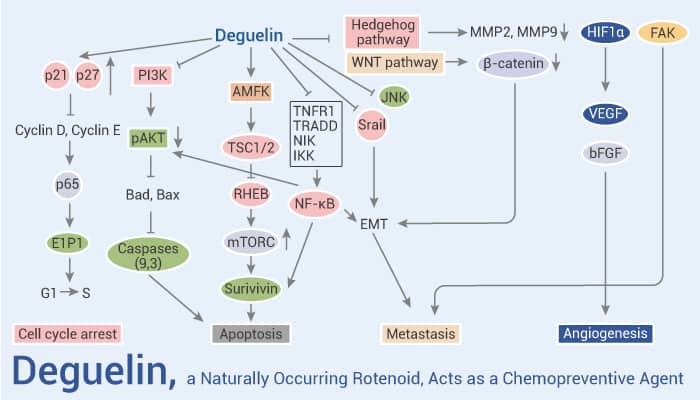Head and neck squamous cell carcinoma (HNSCC) represents more than 5% of all cancers each year. In addition, breast cancer is a heterogeneous group of diseases. Approximately 60-70% of breast cancers express estrogen receptors (ER) and/or progesterone receptors (PR). About 20-30% of breast cancers have amplified levels of the HER2 protein. Deguelin is a natural product isolated from African plant <i>Mundulea sericea</i>. It has antiproliferative actions in various cancers including breast as well as chemopreventive activity against carcinogen-induced experimental cancers. Moreover, it can cause a significant HNSCC cell death.

In cultured HNSCC cells, Deguelin induces both cell apoptosis and autophagy by modulating multiple signaling pathways. Deguelin exposure increases caspase-3 activity, causes caspase-3 and caspase-9 cleavage. Deguelin down-regulates Bcl-xl expression. In cultured Hep-2 cells, deguelin administration caused significant cell viability loss (growth inhibition) in both dose- and time-dependent manners. Furthermore, Deguelin inhibits Akt signaling, and down-regulates survivin and cyclin-dependent kinase 4 (Cdk4) expressions, by disrupting their association with HSP90. It induces ceramide production through de novo synthase pathway to promote HNSCC cell death. Deguelin in a dose and time-dependent manner inhibits the growth of MDA-MB-231, MDA-MB-468, BT-549, and BT-20 cells. Deguelin (2 or 4 mg/kg), reduces the in vivo tumor growth of MDA-MB-231 cells transplanted subcutaneously in athymic mice. It affects EGFR/c-Met and their downstream target molecules such as p-STAT3, p-ERK, p-AKT, c-Myc, and Survivin and thereby affect the growth/survival of breast cancer cells.
In summary, Deguelin is a naturally occurring rotenoid. It acts as a chemopreventive agent by blocking multiple pathways like PI3K-Akt, IKK-NF-κB, and MAPK-mTOR-survivin-mediated apoptosis. Deguelin binding to Hsp90 leads to a decreased expression of numerous oncogenic proteins, including MEK1/2, Akt, HIF1α, COX-2, and NF-κB.
Reference:
Mehta R, et al. PLoS One. 2013 Jun 10;8(6):e65113;Yang YL, et al. PLoS One. 2013;8(1):e54736.